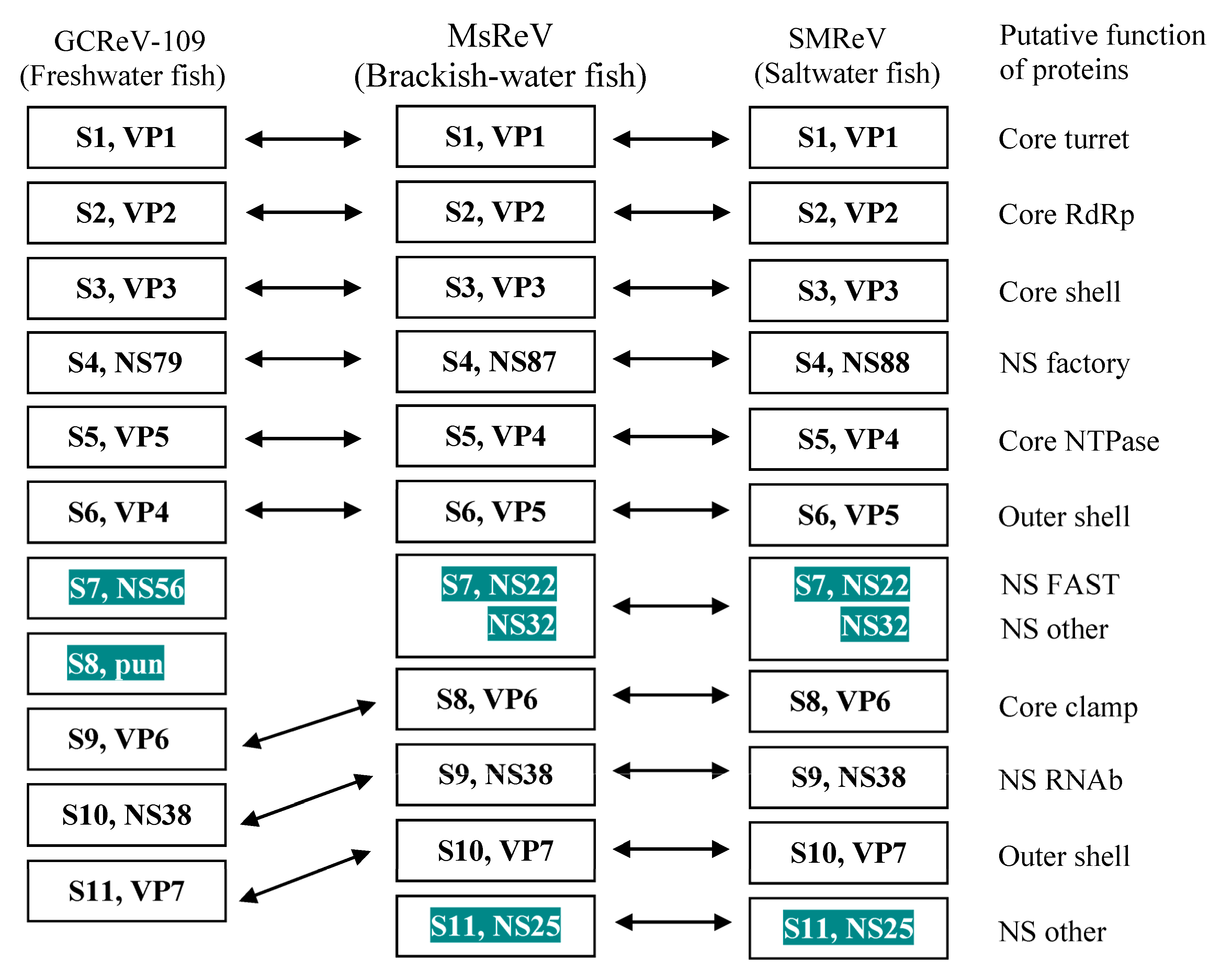|
Aquareovirus
''Aquareovirus'' is a genus of double-stranded RNA viruses in the family ''Reoviridae'' and subfamily ''Spinareovirinae''. Fish, shellfish, and crustacean species serve as natural hosts. Aquareoviruses in general have low or no pathogenicity for fish. However, some cause hemorrhagic disease, hepatitis and pancreatitis. Grass carp hemorrhage virus (causes hemorrhagic disease of grass carp) is the most pathogenic aquareovirus. There are seven species in this genus. Structure Aquareoviruses are non-enveloped, with a double capsid structure that has icosahedral In geometry, an icosahedron ( or ) is a polyhedron with 20 faces. The name comes and . The plural can be either "icosahedra" () or "icosahedrons". There are infinitely many non- similar shapes of icosahedra, some of them being more symmetrica ... geometries, and T=13, T=2 symmetry. The diameter is around 75 nm. Genome Aquareoviruses have double-stranded RNA genomes which are linear and segmented. The total g ... [...More Info...] [...Related Items...] OR: [Wikipedia] [Google] [Baidu] |
Aquareovirus C
The golden shiner virus is an aquatic virus that infects a bait fish known as the golden shiner and to a lesser extent, aquatic animals like crustaceans and molluscs. About 6 virus species have been identified in this genus since the late 1970s.Attoui, H., Fang, Q., Jaafar, F.M., Cantaloube, J., Biagini, P., de Micco, P. & de Lamballerie, X. 2002, "Common evolutionary origin of aquareoviruses and orthoreoviruses revealed by genome characterization of Golden shiner reovirus, Grass carp reovirus, Striped bass reovirus and golden ide reovirus (genus Aquareovirus, family Reoviridae)", Journal of General Virology, vol. 83, no. 8, pp. 1941-1951. It causes death through a hemorrhagic shock. Symptoms include bleeding from the back eyes and the head. The virus is 70 nm in diameter and replicates best at 20-30 degrees Celsius. The virus has properties similar to those of the pancreatic necrosis virus. This could mean that golden shiners are more susceptible in the summer.Schwedler, T. & Plu ... [...More Info...] [...Related Items...] OR: [Wikipedia] [Google] [Baidu] |
Spinareovirinae
''Spinareovirinae'' is a subfamily of double-stranded RNA viruses in the family '' Reoviridae''. Viruses in this group are distinguished by the presence of a turreted protein on the inner capsid A capsid is the protein shell of a virus, enclosing its genetic material. It consists of several oligomeric (repeating) structural subunits made of protein called protomers. The observable 3-dimensional morphological subunits, which may or may .... (''Spina'' = spiny or thorny in Latin.) Taxonomy The subfamily has nine genera: *'' Aquareovirus'' *'' Coltivirus'' *'' Cypovirus'' *'' Dinovernavirus'' *'' Fijivirus'' *'' Idnoreovirus'' *'' Mycoreovirus'' *'' Orthoreovirus'' *'' Oryzavirus'' References Reoviruses Virus subfamilies {{virus-stub ... [...More Info...] [...Related Items...] OR: [Wikipedia] [Google] [Baidu] |
Reoviridae
''Reoviridae'' is a family of double-stranded RNA viruses. Member viruses have a wide host range, including vertebrates, invertebrates, plants, protists and fungi. They lack lipid envelopes and package their segmented genome within multi-layered capsids. Lack of a lipid envelope has allowed three-dimensional structures of these large complex viruses (diameter ∼60–100 nm) to be obtained, revealing a structural and likely evolutionary relationship to the cystovirus family of bacteriophage. There are currently 97 species in this family, divided among 15 genera in two subfamilies. Reoviruses can affect the gastrointestinal system (such as rotaviruses) and respiratory tract. The name "reo-" is an acronym for "''r''espiratory ''e''nteric ''o''rphan" viruses''.'' The term " orphan virus" refers to the fact that some of these viruses have been observed not associated with any known disease. Even though viruses in the family ''Reoviridae'' have more recently been identified with ... [...More Info...] [...Related Items...] OR: [Wikipedia] [Google] [Baidu] |
Icosahedral Symmetry
In mathematics, and especially in geometry, an object has icosahedral symmetry if it has the same symmetries as a regular icosahedron. Examples of other polyhedra with icosahedral symmetry include the regular dodecahedron (the dual of the icosahedron) and the rhombic triacontahedron. Every polyhedron with icosahedral symmetry has 60 rotational (or orientation-preserving) symmetries and 60 orientation-reversing symmetries (that combine a rotation and a reflection), for a total symmetry order of 120. The full symmetry group is the Coxeter group of type . It may be represented by Coxeter notation and Coxeter diagram . The set of rotational symmetries forms a subgroup that is isomorphic to the alternating group on 5 letters. Description Icosahedral symmetry is a mathematical property of objects indicating that an object has the same symmetries as a regular icosahedron. As point group Apart from the two infinite series of prismatic and antiprismatic symm ... [...More Info...] [...Related Items...] OR: [Wikipedia] [Google] [Baidu] |
Base Pair
A base pair (bp) is a fundamental unit of double-stranded nucleic acids consisting of two nucleobases bound to each other by hydrogen bonds. They form the building blocks of the DNA double helix and contribute to the folded structure of both DNA and RNA. Dictated by specific hydrogen bonding patterns, "Watson–Crick" (or "Watson–Crick–Franklin") base pairs ( guanine– cytosine and adenine– thymine) allow the DNA helix to maintain a regular helical structure that is subtly dependent on its nucleotide sequence. The complementary nature of this based-paired structure provides a redundant copy of the genetic information encoded within each strand of DNA. The regular structure and data redundancy provided by the DNA double helix make DNA well suited to the storage of genetic information, while base-pairing between DNA and incoming nucleotides provides the mechanism through which DNA polymerase replicates DNA and RNA polymerase transcribes DNA into RNA. Many DNA-binding p ... [...More Info...] [...Related Items...] OR: [Wikipedia] [Google] [Baidu] |


